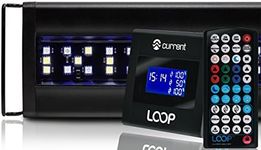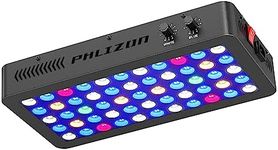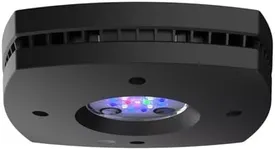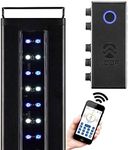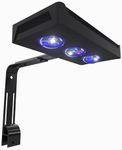Buying Guide for the Best Led Reef Light
Choosing the right LED reef light is crucial for maintaining a healthy and vibrant aquarium. The right light not only helps your corals and marine life thrive, but also enhances the beauty of your tank. When shopping for an LED reef light, it's important to understand the key features and how they relate to the needs of your specific aquarium setup. Consider the types of corals and marine life you have, the size and depth of your tank, and how much control you want over the lighting environment. By focusing on the main specifications, you can find a light that supports both the health of your reef and your enjoyment as an aquarist.Light SpectrumThe light spectrum refers to the range of colors (wavelengths) that the LED light emits. This is important because different corals and marine organisms require specific wavelengths for photosynthesis and growth, especially in the blue and actinic ranges. Some lights offer a full spectrum, which can support a wider variety of corals and enhance the natural colors in your tank. When comparing lights, you'll see options ranging from basic blue/white combinations to advanced models with customizable spectrums. If you keep mostly soft corals or fish, a simpler spectrum may suffice, but for mixed or SPS-dominated reefs, a broader and adjustable spectrum is usually better.
PAR (Photosynthetically Active Radiation)PAR measures the amount of usable light for photosynthesis that reaches your corals. This is a key factor because corals need a certain level of PAR to grow and stay healthy. PAR values can vary widely between lights and depend on the depth of your tank. Lower PAR is suitable for soft corals and shallow tanks, while higher PAR is needed for demanding SPS corals or deeper tanks. When choosing, consider the types of corals you keep and the depth of your aquarium—match the PAR output to those needs for best results.
Coverage AreaCoverage area describes how much of your tank the light can effectively illuminate. This is important to ensure all your corals receive adequate light. Lights are rated for different tank sizes and shapes, and the coverage can be affected by mounting height and lens design. For small or narrow tanks, a single fixture may be enough, while larger or wider tanks may need multiple units or a fixture with a broader spread. Always check the recommended coverage for your tank dimensions to avoid dark spots or uneven lighting.
Control and ProgrammabilityControl and programmability refer to how much you can adjust the light's intensity, spectrum, and schedule. Some lights offer simple on/off switches, while others allow you to set custom lighting schedules, simulate sunrise and sunset, or adjust individual color channels. This is important for replicating natural lighting conditions and supporting coral health. If you enjoy fine-tuning your tank environment or want to automate lighting changes, look for lights with advanced control features. For a more hands-off approach, basic controls may be sufficient.
Build Quality and WaterproofingBuild quality and waterproofing determine how well the light will hold up in the humid, salty environment above a reef tank. Good build quality means the light will last longer and be safer to use. Waterproof or water-resistant features protect the electronics from splashes and condensation. When comparing lights, look for sturdy materials, sealed housings, and user reviews about durability. If your light will be close to the water or in a canopy, higher waterproofing is especially important.
Heat ManagementHeat management refers to how the light handles the heat it generates. Excess heat can shorten the lifespan of LEDs and affect your tank's temperature. Some lights use passive cooling (heat sinks), while others have active cooling (fans). For smaller tanks or open setups, passive cooling may be enough, but for larger or enclosed tanks, active cooling can help prevent overheating. Consider your tank's setup and ventilation when choosing a light with the right heat management.

